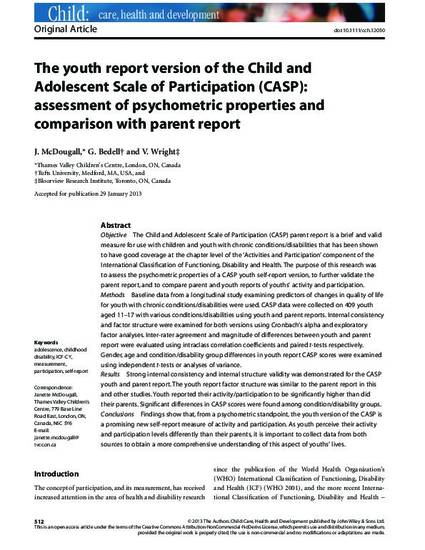
Objective The Child and Adolescent Scale of Participation (CASP) parent report is a brief and valid measure for use with children and youth with chronic conditions/disabilities that has been shown to have good coverage at the chapter level of the‘Activities and Participation’component of the International Classification of Functioning,Disability and Health.The purpose of this research was to assess the psychometric properties of a CASP youth self-report version,to further validate the parent report,and to compare parent and youth reports of youths’ activity and participation.
Methods Baseline data from a longitudinal study examining predictors of changes in quality of life for youth with chronic conditions/disabilities were used.CASP data were collected on 409 youth aged 11–17 with various conditions/disabilities using youth and parent reports.Internal consistency and factor structure were examined for both versions using Cronbach’s alpha and exploratory factor analyses.Inter-rater agreement and magnitude of differences between youth and parent report were evaluated using intraclass correlation coefficients and paired t-tests respectively. Gender,age and condition/disability group differences in youth report CASP scores were examined using independent t-tests or analyses of variance.
Results Strong internal consistency and internal structure validity was demonstrated for the CASP youth and parent report.The youth report factor structure was similar to the parent report in this and other studies.Youth reported their activity/participation to be significantly higher than did their parents.Significant differences in CASP scores were found among condition/disability groups.
Conclusions Findings show that,from a psychometric standpoint,the youth version of the CASP is a promising new self-report measure of activity and participation.As youth perceive their activity and participation levels differently than their parents,it is important to collect data from both sources to obtain a more comprehensive understanding of this aspect of youths’ lives.
Available at: http://works.bepress.com/janette-mcdougall/70/

This is an open access article originally published in Child: Care, Health and Development.